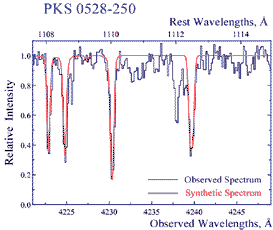Fundamental Physical Constants
Modern theories of fundamental intaractions (SUSY GUT,
Superstring/M-theory and others) not only predict the
dependence of fundamental physical constants on energy
("running" constants), but also have cosmological
solutions in which low-energy values of these constants vary
with the cosmological time.
The predicted variations at
the present epoch are small but non-zero, and they depend on
theoretical model used. Clearly, a discovery of these
variations would be a great step in our understanding of
Nature. Even a reliable upper bound on a possible variation
rate of a fundamental constant presents an effective tool for
selecting viable theoretical models.
The main attention we pay
to the following constants:
|
the fine-structure constant |
α
= e2/ħc
|
|
proton-to-electron mass ratio |
μ
= mp/me
|
Different theoretical models of the fundamental physical interactions predict
different variations of their values and different relations between
cosmological deviations of the constants (α, μ, and others, see
Calmet & Fritzsch hep-ph/0112110,
Langacker et al. hep-ph/0112233 ,
Olive et al. hep-ph/0205269 ,
Dent & Fairbairn hep-ph/0112279 ).
Therefore, it is crucial to couple measurement of different dimensionless fundamental constants.
 Presently, the fundamental constants are being measured with a
relative error of ~10-8 (Physical Reference Data
NIST).
These measurements obviously rule out
considerable variations of the constants on a short time scale, but
do not exclude their changes over the entire lifetime of the Universe,
~1.5x1010 years. Moreover, one cannot rule out the
possibility that the coupling constants differ in widely separated regions
of the Universe; THIS COULD DE DISPROVED ONLY by EXPERIMENTS and OBSERVATIONS !
Presently, the fundamental constants are being measured with a
relative error of ~10-8 (Physical Reference Data
NIST).
These measurements obviously rule out
considerable variations of the constants on a short time scale, but
do not exclude their changes over the entire lifetime of the Universe,
~1.5x1010 years. Moreover, one cannot rule out the
possibility that the coupling constants differ in widely separated regions
of the Universe; THIS COULD DE DISPROVED ONLY by EXPERIMENTS and OBSERVATIONS !
It is extremely difficult to increase the accuracy of the present-day
experiments and trace possible variation of the fundamental constants
during cosmological evolution of the Universe. Fortunately, Nature
has provided us with a tool for direct measuring the physical constants
in the early epoches. This tool is based on observations of quasars (QSO)
- the most powerful source of radiation.
Many quasars belong to the most distant objects we can observe. Light
from the distant quasars travels to us about 1010 years. This
means that the quasar spectra registered now were formed ~1010
years ago. Because of the expansion of the Universe, distant objects
recede from us at a great velocity. As a result, the wavelengths of the
lines observed in spectra of these objects λobs
increase compared to their laboratory values λlab
in proportion λobs =
λlab(1+z), where the cosmological redshift z
can be used to determine the age of the Universe at the line-formation
epoch.
Analyzing these spectra we may study the epoch when the Universe was
several times younger than now. Thus, the quasar spectra are true keepers
of the history of the Universe as its space-time photos.
A new limit on the possible cosmological variation of the proton-to-electron mass
ratio μ is estimated by measuring wavelengths of H2
lines of Lyman and Werner bands from two absorption systems at
zabs = 2.5947 (profiles of the H2 lines) and
3.0249 (profiles of the H2 lines) in the spectra of
quasars Q 0405-443 and Q 0347-383, respectively.
Data are of the highest spectral resolution (R = 53000) and S/N ratio (30 - 70) for this
kind of study.
We search for any correlation between zi, the redshift of observed lines, determined
using laboratory wavelengths as references, and Ki, the sensitivity coefficient of
the lines to a change of μ, that could be interpreted as a variation
of μ
over the corresponding cosmological time.
We use two sets of laboratory wavelengths, the first one,
Set (A) (H. Abgrall, E. Roueff, F. Launay, J.-Y. Roncin, & J.-L. Subtil, 1993, J. of Mol. Spec.,
157, 512), based on experimental determination of energy levels and the second one,
Set (P) (J. Philip, J.P. Sprengers, Th. Pielage, C.A. Lange, W. Ubachs, & E. Reinhold, 2004,
Can. J. Chem., 82, 713), based on new laboratory measurements of some individual rest-wavelengths.
We find Δμ/μ = ( 3.05 ± 0.75 )×10-5 for Set (A),
and Δμ/μ = ( 1.65 ± 0.74 )×10-5 for Set (P).
The second determination is the most stringent limit on the variation of μ
over the last 12~Gyrs ever obtained. The correlation found using Set (A) seems to show that
some amount of systematic error is hidden in the determination of energy levels
of the H2 molecule.
is
Δμ/μ=( 1.65 ± 0.74 )×10-5
 Presently, the fundamental constants are being measured with a
relative error of ~10-8 (Physical Reference Data
NIST).
These measurements obviously rule out
considerable variations of the constants on a short time scale, but
do not exclude their changes over the entire lifetime of the Universe,
~1.5x1010 years. Moreover, one cannot rule out the
possibility that the coupling constants differ in widely separated regions
of the Universe; THIS COULD DE DISPROVED ONLY by EXPERIMENTS and OBSERVATIONS !
Presently, the fundamental constants are being measured with a
relative error of ~10-8 (Physical Reference Data
NIST).
These measurements obviously rule out
considerable variations of the constants on a short time scale, but
do not exclude their changes over the entire lifetime of the Universe,
~1.5x1010 years. Moreover, one cannot rule out the
possibility that the coupling constants differ in widely separated regions
of the Universe; THIS COULD DE DISPROVED ONLY by EXPERIMENTS and OBSERVATIONS !